Economics Assignment: Short-Run & Long-Run Costs, Market Equilibrium
VerifiedAdded on 2022/01/19
|5
|1991
|52
Homework Assignment
AI Summary
This assignment delves into key microeconomic concepts, beginning with an analysis of the relationship between short-run and long-run average costs, emphasizing the impact of fixed and variable costs. It explains how the U-shaped cost curves are formed and the significance of opportunity cost in both the short and long run. The assignment further explores market dynamics, including the forces of supply and demand, the effects of regulations and subsidies on market clearing prices, and the implications of price controls. Additionally, it defines market equilibrium and disequilibrium, examining the factors influencing supply and demand, and their impact on market prices and quantity for normal goods, including the role of surpluses and shortages in driving market adjustments. The document also provides a comprehensive understanding of the factors that cause market disequilibrium, such as price rigidity and government interventions, and how these imbalances are resolved through market forces or government intervention.
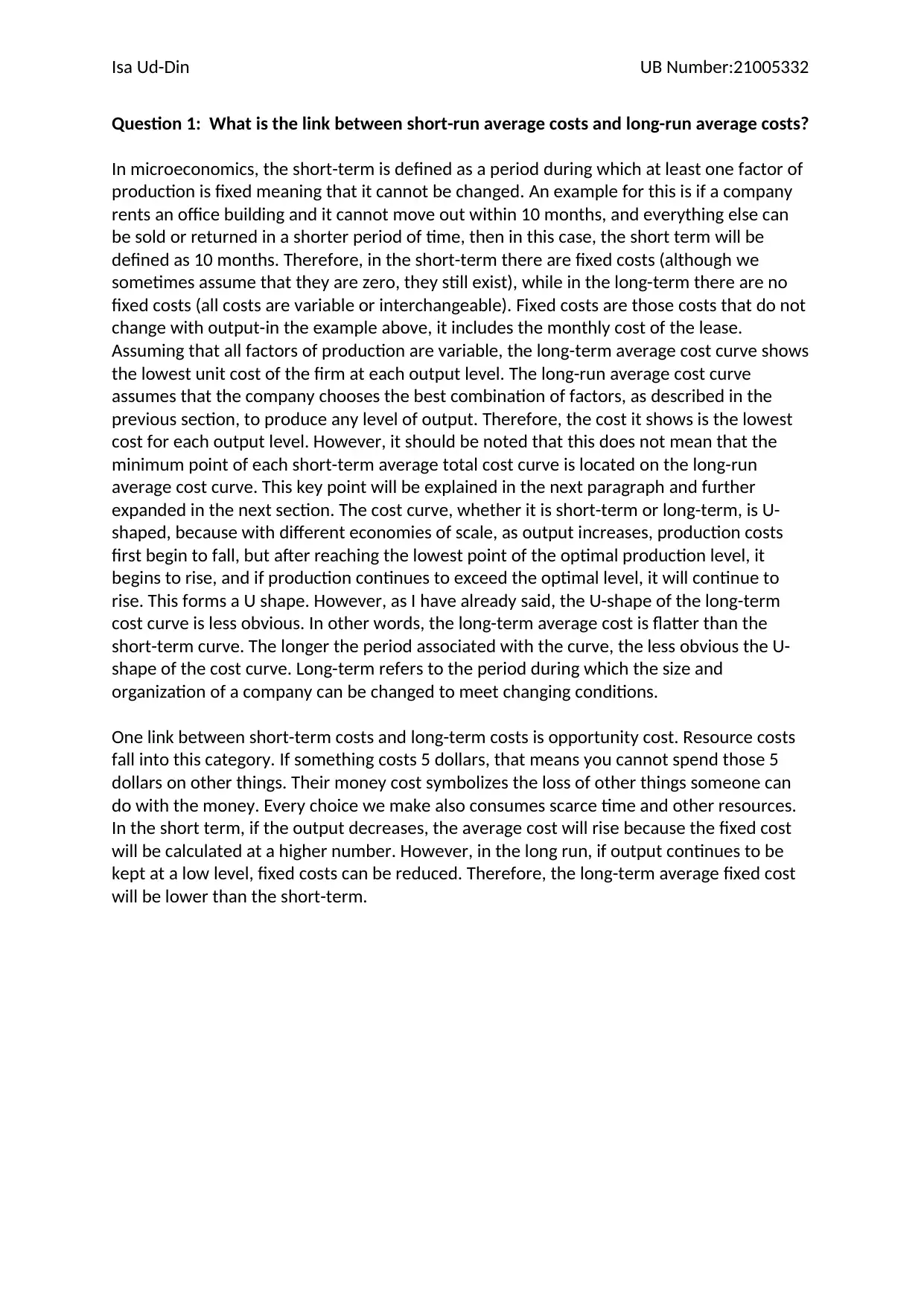
Isa Ud-Din UB Number:21005332
Question 1: What is the link between short-run average costs and long-run average costs?
In microeconomics, the short-term is defined as a period during which at least one factor of
production is fixed meaning that it cannot be changed. An example for this is if a company
rents an office building and it cannot move out within 10 months, and everything else can
be sold or returned in a shorter period of time, then in this case, the short term will be
defined as 10 months. Therefore, in the short-term there are fixed costs (although we
sometimes assume that they are zero, they still exist), while in the long-term there are no
fixed costs (all costs are variable or interchangeable). Fixed costs are those costs that do not
change with output-in the example above, it includes the monthly cost of the lease.
Assuming that all factors of production are variable, the long-term average cost curve shows
the lowest unit cost of the firm at each output level. The long-run average cost curve
assumes that the company chooses the best combination of factors, as described in the
previous section, to produce any level of output. Therefore, the cost it shows is the lowest
cost for each output level. However, it should be noted that this does not mean that the
minimum point of each short-term average total cost curve is located on the long-run
average cost curve. This key point will be explained in the next paragraph and further
expanded in the next section. The cost curve, whether it is short-term or long-term, is U-
shaped, because with different economies of scale, as output increases, production costs
first begin to fall, but after reaching the lowest point of the optimal production level, it
begins to rise, and if production continues to exceed the optimal level, it will continue to
rise. This forms a U shape. However, as I have already said, the U-shape of the long-term
cost curve is less obvious. In other words, the long-term average cost is flatter than the
short-term curve. The longer the period associated with the curve, the less obvious the U-
shape of the cost curve. Long-term refers to the period during which the size and
organization of a company can be changed to meet changing conditions.
One link between short-term costs and long-term costs is opportunity cost. Resource costs
fall into this category. If something costs 5 dollars, that means you cannot spend those 5
dollars on other things. Their money cost symbolizes the loss of other things someone can
do with the money. Every choice we make also consumes scarce time and other resources.
In the short term, if the output decreases, the average cost will rise because the fixed cost
will be calculated at a higher number. However, in the long run, if output continues to be
kept at a low level, fixed costs can be reduced. Therefore, the long-term average fixed cost
will be lower than the short-term.
Question 1: What is the link between short-run average costs and long-run average costs?
In microeconomics, the short-term is defined as a period during which at least one factor of
production is fixed meaning that it cannot be changed. An example for this is if a company
rents an office building and it cannot move out within 10 months, and everything else can
be sold or returned in a shorter period of time, then in this case, the short term will be
defined as 10 months. Therefore, in the short-term there are fixed costs (although we
sometimes assume that they are zero, they still exist), while in the long-term there are no
fixed costs (all costs are variable or interchangeable). Fixed costs are those costs that do not
change with output-in the example above, it includes the monthly cost of the lease.
Assuming that all factors of production are variable, the long-term average cost curve shows
the lowest unit cost of the firm at each output level. The long-run average cost curve
assumes that the company chooses the best combination of factors, as described in the
previous section, to produce any level of output. Therefore, the cost it shows is the lowest
cost for each output level. However, it should be noted that this does not mean that the
minimum point of each short-term average total cost curve is located on the long-run
average cost curve. This key point will be explained in the next paragraph and further
expanded in the next section. The cost curve, whether it is short-term or long-term, is U-
shaped, because with different economies of scale, as output increases, production costs
first begin to fall, but after reaching the lowest point of the optimal production level, it
begins to rise, and if production continues to exceed the optimal level, it will continue to
rise. This forms a U shape. However, as I have already said, the U-shape of the long-term
cost curve is less obvious. In other words, the long-term average cost is flatter than the
short-term curve. The longer the period associated with the curve, the less obvious the U-
shape of the cost curve. Long-term refers to the period during which the size and
organization of a company can be changed to meet changing conditions.
One link between short-term costs and long-term costs is opportunity cost. Resource costs
fall into this category. If something costs 5 dollars, that means you cannot spend those 5
dollars on other things. Their money cost symbolizes the loss of other things someone can
do with the money. Every choice we make also consumes scarce time and other resources.
In the short term, if the output decreases, the average cost will rise because the fixed cost
will be calculated at a higher number. However, in the long run, if output continues to be
kept at a low level, fixed costs can be reduced. Therefore, the long-term average fixed cost
will be lower than the short-term.
Paraphrase This Document
Need a fresh take? Get an instant paraphrase of this document with our AI Paraphraser
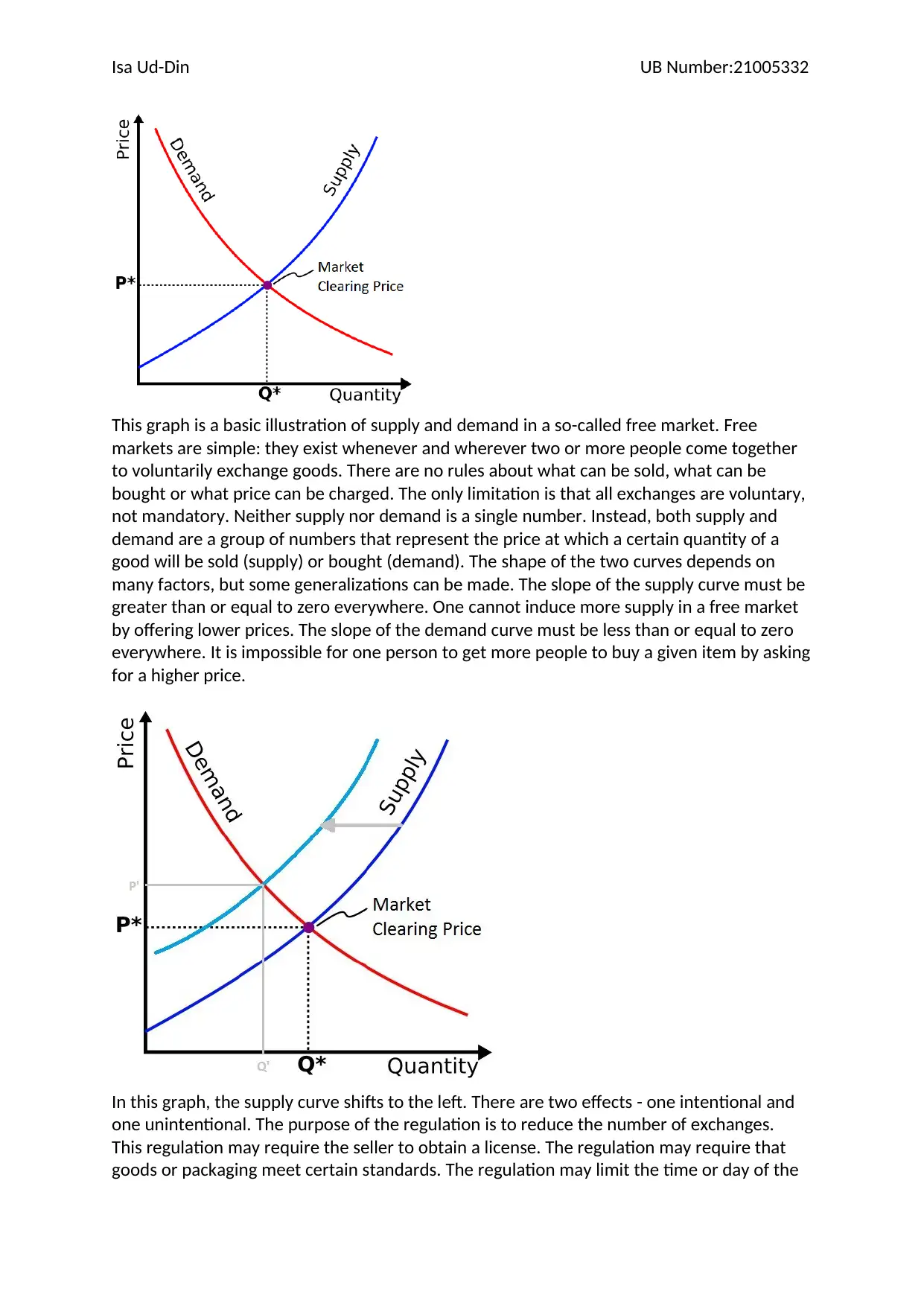
Isa Ud-Din UB Number:21005332
This graph is a basic illustration of supply and demand in a so-called free market. Free
markets are simple: they exist whenever and wherever two or more people come together
to voluntarily exchange goods. There are no rules about what can be sold, what can be
bought or what price can be charged. The only limitation is that all exchanges are voluntary,
not mandatory. Neither supply nor demand is a single number. Instead, both supply and
demand are a group of numbers that represent the price at which a certain quantity of a
good will be sold (supply) or bought (demand). The shape of the two curves depends on
many factors, but some generalizations can be made. The slope of the supply curve must be
greater than or equal to zero everywhere. One cannot induce more supply in a free market
by offering lower prices. The slope of the demand curve must be less than or equal to zero
everywhere. It is impossible for one person to get more people to buy a given item by asking
for a higher price.
In this graph, the supply curve shifts to the left. There are two effects - one intentional and
one unintentional. The purpose of the regulation is to reduce the number of exchanges.
This regulation may require the seller to obtain a license. The regulation may require that
goods or packaging meet certain standards. The regulation may limit the time or day of the
This graph is a basic illustration of supply and demand in a so-called free market. Free
markets are simple: they exist whenever and wherever two or more people come together
to voluntarily exchange goods. There are no rules about what can be sold, what can be
bought or what price can be charged. The only limitation is that all exchanges are voluntary,
not mandatory. Neither supply nor demand is a single number. Instead, both supply and
demand are a group of numbers that represent the price at which a certain quantity of a
good will be sold (supply) or bought (demand). The shape of the two curves depends on
many factors, but some generalizations can be made. The slope of the supply curve must be
greater than or equal to zero everywhere. One cannot induce more supply in a free market
by offering lower prices. The slope of the demand curve must be less than or equal to zero
everywhere. It is impossible for one person to get more people to buy a given item by asking
for a higher price.
In this graph, the supply curve shifts to the left. There are two effects - one intentional and
one unintentional. The purpose of the regulation is to reduce the number of exchanges.
This regulation may require the seller to obtain a license. The regulation may require that
goods or packaging meet certain standards. The regulation may limit the time or day of the
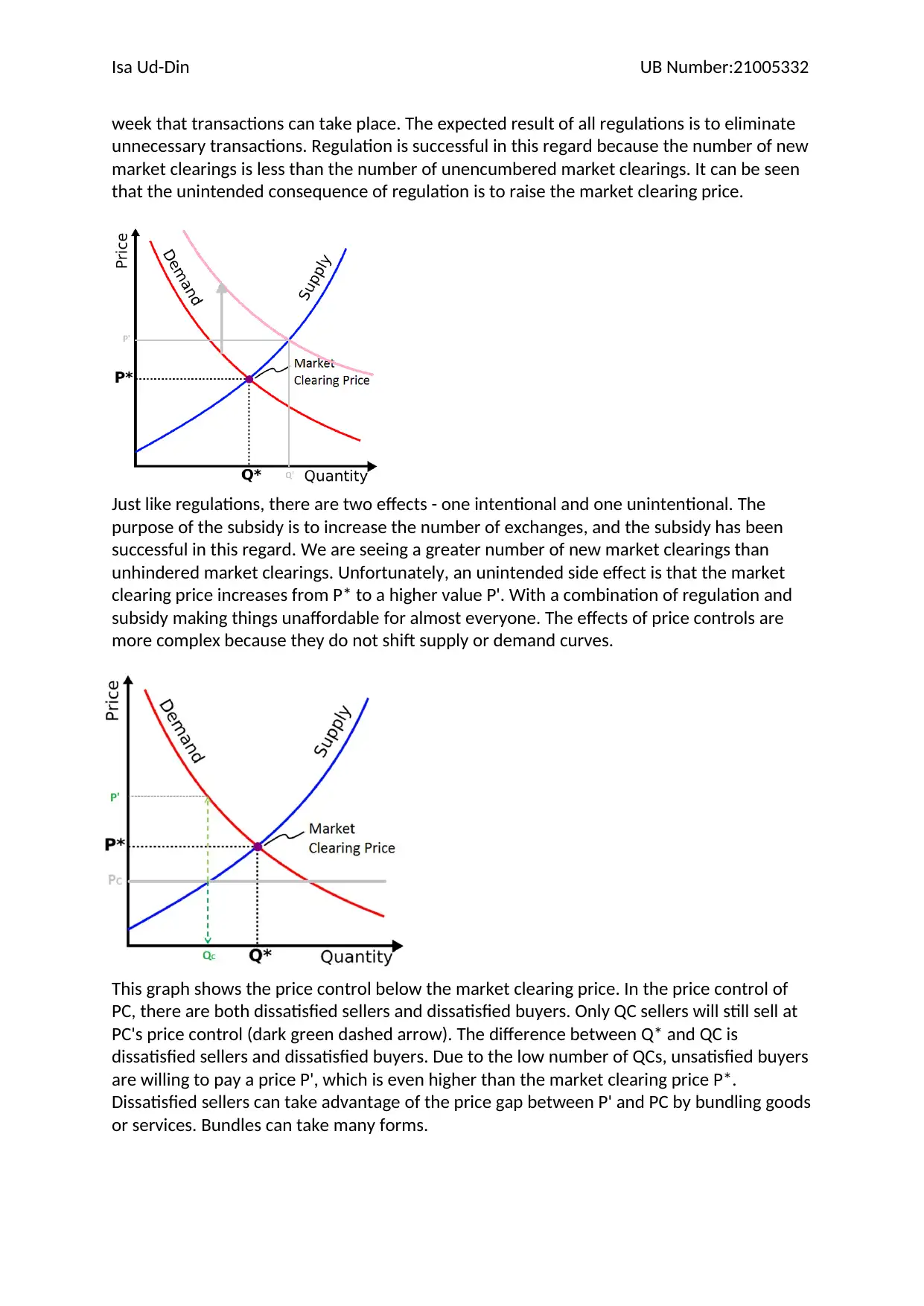
Isa Ud-Din UB Number:21005332
week that transactions can take place. The expected result of all regulations is to eliminate
unnecessary transactions. Regulation is successful in this regard because the number of new
market clearings is less than the number of unencumbered market clearings. It can be seen
that the unintended consequence of regulation is to raise the market clearing price.
Just like regulations, there are two effects - one intentional and one unintentional. The
purpose of the subsidy is to increase the number of exchanges, and the subsidy has been
successful in this regard. We are seeing a greater number of new market clearings than
unhindered market clearings. Unfortunately, an unintended side effect is that the market
clearing price increases from P* to a higher value P'. With a combination of regulation and
subsidy making things unaffordable for almost everyone. The effects of price controls are
more complex because they do not shift supply or demand curves.
This graph shows the price control below the market clearing price. In the price control of
PC, there are both dissatisfied sellers and dissatisfied buyers. Only QC sellers will still sell at
PC's price control (dark green dashed arrow). The difference between Q* and QC is
dissatisfied sellers and dissatisfied buyers. Due to the low number of QCs, unsatisfied buyers
are willing to pay a price P', which is even higher than the market clearing price P*.
Dissatisfied sellers can take advantage of the price gap between P' and PC by bundling goods
or services. Bundles can take many forms.
week that transactions can take place. The expected result of all regulations is to eliminate
unnecessary transactions. Regulation is successful in this regard because the number of new
market clearings is less than the number of unencumbered market clearings. It can be seen
that the unintended consequence of regulation is to raise the market clearing price.
Just like regulations, there are two effects - one intentional and one unintentional. The
purpose of the subsidy is to increase the number of exchanges, and the subsidy has been
successful in this regard. We are seeing a greater number of new market clearings than
unhindered market clearings. Unfortunately, an unintended side effect is that the market
clearing price increases from P* to a higher value P'. With a combination of regulation and
subsidy making things unaffordable for almost everyone. The effects of price controls are
more complex because they do not shift supply or demand curves.
This graph shows the price control below the market clearing price. In the price control of
PC, there are both dissatisfied sellers and dissatisfied buyers. Only QC sellers will still sell at
PC's price control (dark green dashed arrow). The difference between Q* and QC is
dissatisfied sellers and dissatisfied buyers. Due to the low number of QCs, unsatisfied buyers
are willing to pay a price P', which is even higher than the market clearing price P*.
Dissatisfied sellers can take advantage of the price gap between P' and PC by bundling goods
or services. Bundles can take many forms.
⊘ This is a preview!⊘
Do you want full access?
Subscribe today to unlock all pages.

Trusted by 1+ million students worldwide
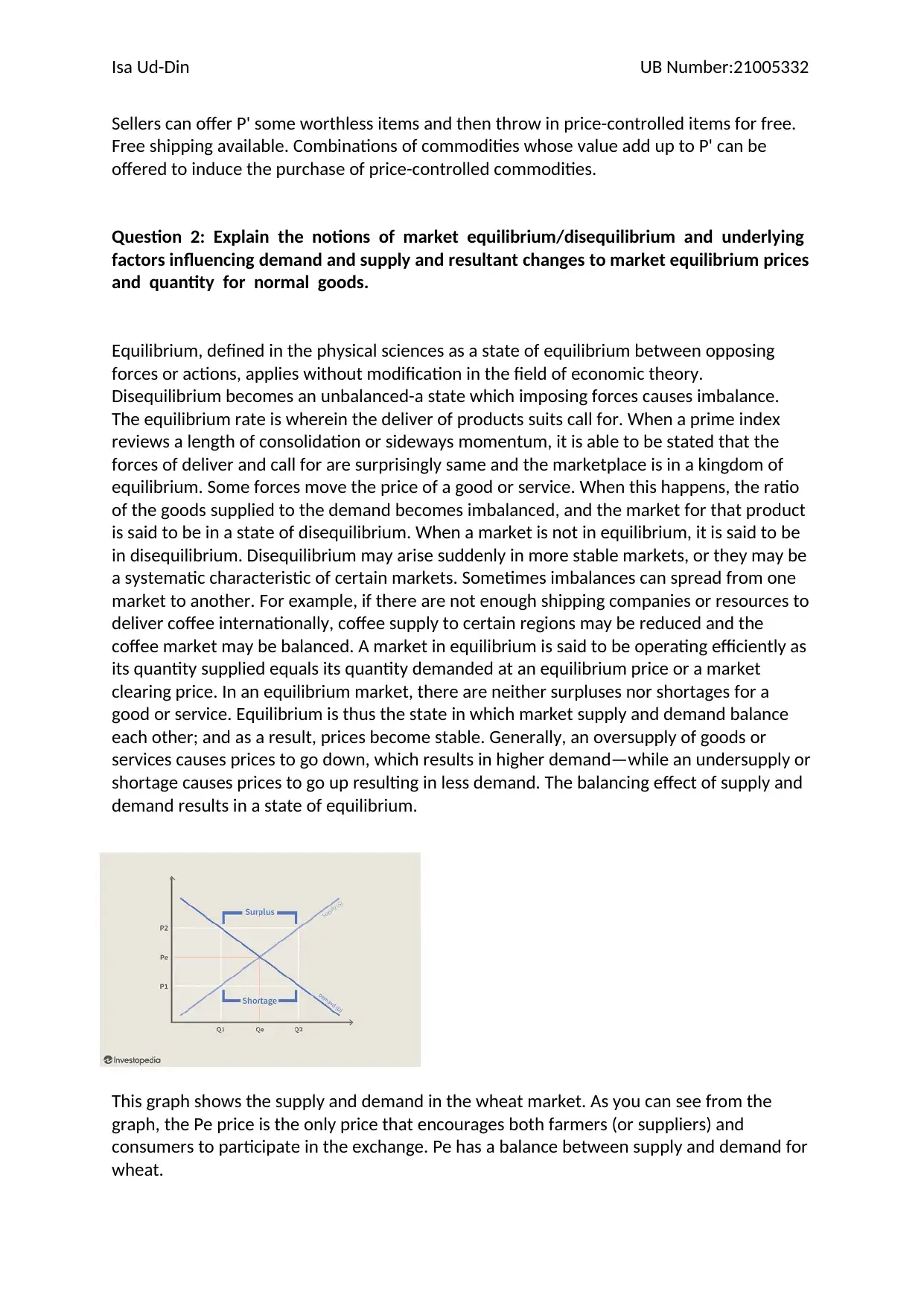
Isa Ud-Din UB Number:21005332
Sellers can offer P' some worthless items and then throw in price-controlled items for free.
Free shipping available. Combinations of commodities whose value add up to P' can be
offered to induce the purchase of price-controlled commodities.
Question 2: Explain the notions of market equilibrium/disequilibrium and underlying
factors influencing demand and supply and resultant changes to market equilibrium prices
and quantity for normal goods.
Equilibrium, defined in the physical sciences as a state of equilibrium between opposing
forces or actions, applies without modification in the field of economic theory.
Disequilibrium becomes an unbalanced-a state which imposing forces causes imbalance.
The equilibrium rate is wherein the deliver of products suits call for. When a prime index
reviews a length of consolidation or sideways momentum, it is able to be stated that the
forces of deliver and call for are surprisingly same and the marketplace is in a kingdom of
equilibrium. Some forces move the price of a good or service. When this happens, the ratio
of the goods supplied to the demand becomes imbalanced, and the market for that product
is said to be in a state of disequilibrium. When a market is not in equilibrium, it is said to be
in disequilibrium. Disequilibrium may arise suddenly in more stable markets, or they may be
a systematic characteristic of certain markets. Sometimes imbalances can spread from one
market to another. For example, if there are not enough shipping companies or resources to
deliver coffee internationally, coffee supply to certain regions may be reduced and the
coffee market may be balanced. A market in equilibrium is said to be operating efficiently as
its quantity supplied equals its quantity demanded at an equilibrium price or a market
clearing price. In an equilibrium market, there are neither surpluses nor shortages for a
good or service. Equilibrium is thus the state in which market supply and demand balance
each other; and as a result, prices become stable. Generally, an oversupply of goods or
services causes prices to go down, which results in higher demand—while an undersupply or
shortage causes prices to go up resulting in less demand. The balancing effect of supply and
demand results in a state of equilibrium.
This graph shows the supply and demand in the wheat market. As you can see from the
graph, the Pe price is the only price that encourages both farmers (or suppliers) and
consumers to participate in the exchange. Pe has a balance between supply and demand for
wheat.
Sellers can offer P' some worthless items and then throw in price-controlled items for free.
Free shipping available. Combinations of commodities whose value add up to P' can be
offered to induce the purchase of price-controlled commodities.
Question 2: Explain the notions of market equilibrium/disequilibrium and underlying
factors influencing demand and supply and resultant changes to market equilibrium prices
and quantity for normal goods.
Equilibrium, defined in the physical sciences as a state of equilibrium between opposing
forces or actions, applies without modification in the field of economic theory.
Disequilibrium becomes an unbalanced-a state which imposing forces causes imbalance.
The equilibrium rate is wherein the deliver of products suits call for. When a prime index
reviews a length of consolidation or sideways momentum, it is able to be stated that the
forces of deliver and call for are surprisingly same and the marketplace is in a kingdom of
equilibrium. Some forces move the price of a good or service. When this happens, the ratio
of the goods supplied to the demand becomes imbalanced, and the market for that product
is said to be in a state of disequilibrium. When a market is not in equilibrium, it is said to be
in disequilibrium. Disequilibrium may arise suddenly in more stable markets, or they may be
a systematic characteristic of certain markets. Sometimes imbalances can spread from one
market to another. For example, if there are not enough shipping companies or resources to
deliver coffee internationally, coffee supply to certain regions may be reduced and the
coffee market may be balanced. A market in equilibrium is said to be operating efficiently as
its quantity supplied equals its quantity demanded at an equilibrium price or a market
clearing price. In an equilibrium market, there are neither surpluses nor shortages for a
good or service. Equilibrium is thus the state in which market supply and demand balance
each other; and as a result, prices become stable. Generally, an oversupply of goods or
services causes prices to go down, which results in higher demand—while an undersupply or
shortage causes prices to go up resulting in less demand. The balancing effect of supply and
demand results in a state of equilibrium.
This graph shows the supply and demand in the wheat market. As you can see from the
graph, the Pe price is the only price that encourages both farmers (or suppliers) and
consumers to participate in the exchange. Pe has a balance between supply and demand for
wheat.
Paraphrase This Document
Need a fresh take? Get an instant paraphrase of this document with our AI Paraphraser
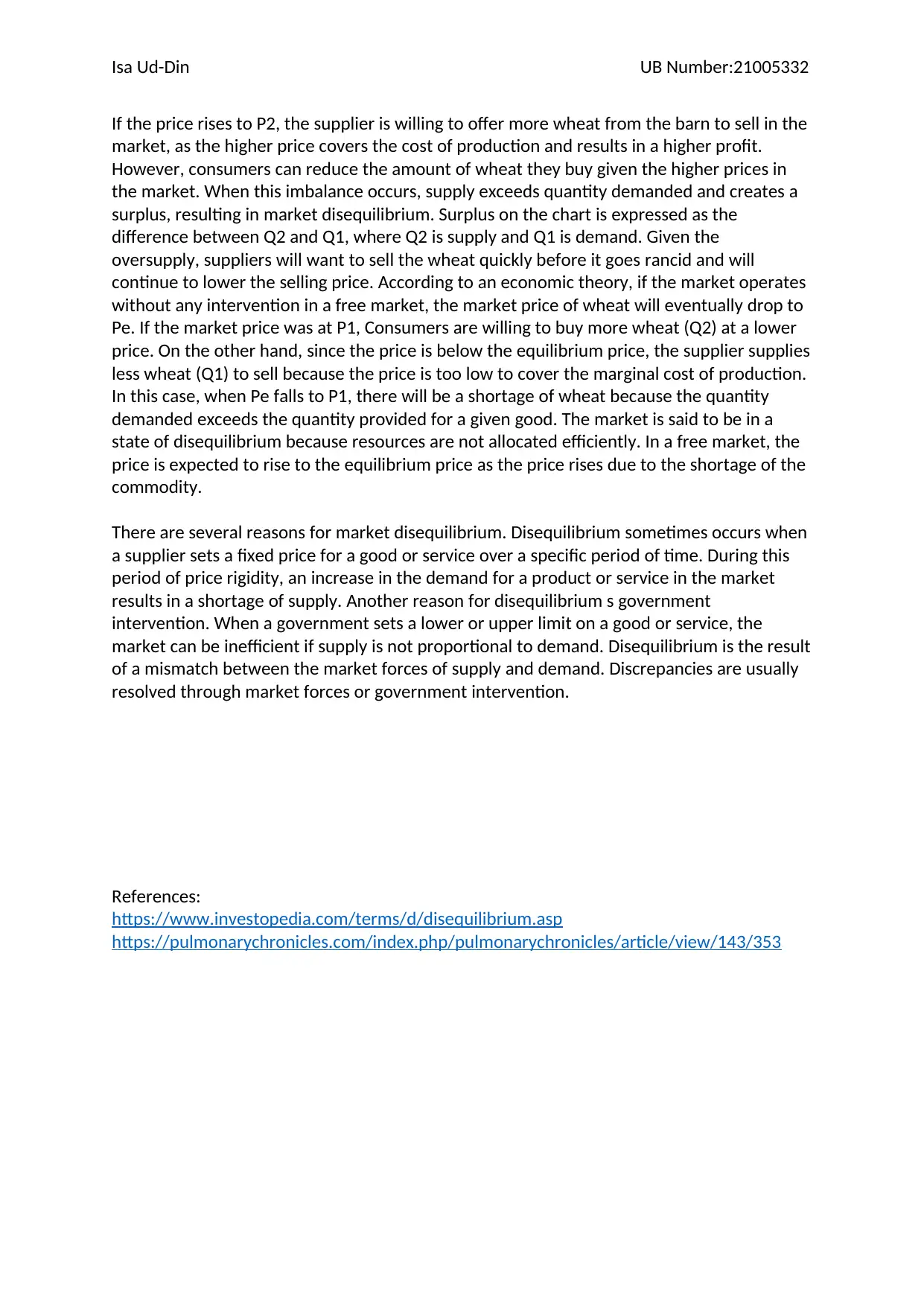
Isa Ud-Din UB Number:21005332
If the price rises to P2, the supplier is willing to offer more wheat from the barn to sell in the
market, as the higher price covers the cost of production and results in a higher profit.
However, consumers can reduce the amount of wheat they buy given the higher prices in
the market. When this imbalance occurs, supply exceeds quantity demanded and creates a
surplus, resulting in market disequilibrium. Surplus on the chart is expressed as the
difference between Q2 and Q1, where Q2 is supply and Q1 is demand. Given the
oversupply, suppliers will want to sell the wheat quickly before it goes rancid and will
continue to lower the selling price. According to an economic theory, if the market operates
without any intervention in a free market, the market price of wheat will eventually drop to
Pe. If the market price was at P1, Consumers are willing to buy more wheat (Q2) at a lower
price. On the other hand, since the price is below the equilibrium price, the supplier supplies
less wheat (Q1) to sell because the price is too low to cover the marginal cost of production.
In this case, when Pe falls to P1, there will be a shortage of wheat because the quantity
demanded exceeds the quantity provided for a given good. The market is said to be in a
state of disequilibrium because resources are not allocated efficiently. In a free market, the
price is expected to rise to the equilibrium price as the price rises due to the shortage of the
commodity.
There are several reasons for market disequilibrium. Disequilibrium sometimes occurs when
a supplier sets a fixed price for a good or service over a specific period of time. During this
period of price rigidity, an increase in the demand for a product or service in the market
results in a shortage of supply. Another reason for disequilibrium s government
intervention. When a government sets a lower or upper limit on a good or service, the
market can be inefficient if supply is not proportional to demand. Disequilibrium is the result
of a mismatch between the market forces of supply and demand. Discrepancies are usually
resolved through market forces or government intervention.
References:
https://www.investopedia.com/terms/d/disequilibrium.asp
https://pulmonarychronicles.com/index.php/pulmonarychronicles/article/view/143/353
If the price rises to P2, the supplier is willing to offer more wheat from the barn to sell in the
market, as the higher price covers the cost of production and results in a higher profit.
However, consumers can reduce the amount of wheat they buy given the higher prices in
the market. When this imbalance occurs, supply exceeds quantity demanded and creates a
surplus, resulting in market disequilibrium. Surplus on the chart is expressed as the
difference between Q2 and Q1, where Q2 is supply and Q1 is demand. Given the
oversupply, suppliers will want to sell the wheat quickly before it goes rancid and will
continue to lower the selling price. According to an economic theory, if the market operates
without any intervention in a free market, the market price of wheat will eventually drop to
Pe. If the market price was at P1, Consumers are willing to buy more wheat (Q2) at a lower
price. On the other hand, since the price is below the equilibrium price, the supplier supplies
less wheat (Q1) to sell because the price is too low to cover the marginal cost of production.
In this case, when Pe falls to P1, there will be a shortage of wheat because the quantity
demanded exceeds the quantity provided for a given good. The market is said to be in a
state of disequilibrium because resources are not allocated efficiently. In a free market, the
price is expected to rise to the equilibrium price as the price rises due to the shortage of the
commodity.
There are several reasons for market disequilibrium. Disequilibrium sometimes occurs when
a supplier sets a fixed price for a good or service over a specific period of time. During this
period of price rigidity, an increase in the demand for a product or service in the market
results in a shortage of supply. Another reason for disequilibrium s government
intervention. When a government sets a lower or upper limit on a good or service, the
market can be inefficient if supply is not proportional to demand. Disequilibrium is the result
of a mismatch between the market forces of supply and demand. Discrepancies are usually
resolved through market forces or government intervention.
References:
https://www.investopedia.com/terms/d/disequilibrium.asp
https://pulmonarychronicles.com/index.php/pulmonarychronicles/article/view/143/353
1 out of 5
Related Documents
Your All-in-One AI-Powered Toolkit for Academic Success.
+13062052269
info@desklib.com
Available 24*7 on WhatsApp / Email
![[object Object]](/_next/static/media/star-bottom.7253800d.svg)
Unlock your academic potential
Copyright © 2020–2025 A2Z Services. All Rights Reserved. Developed and managed by ZUCOL.





